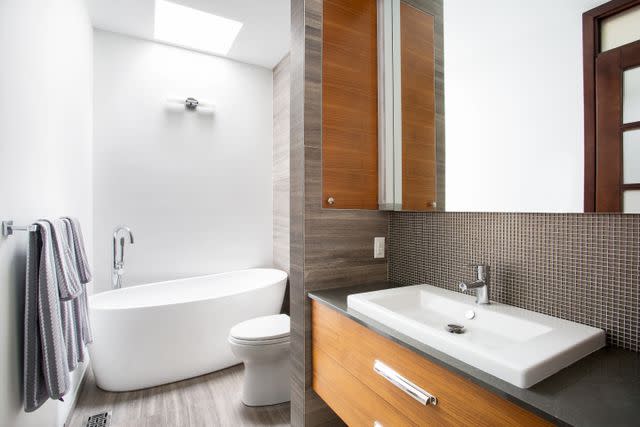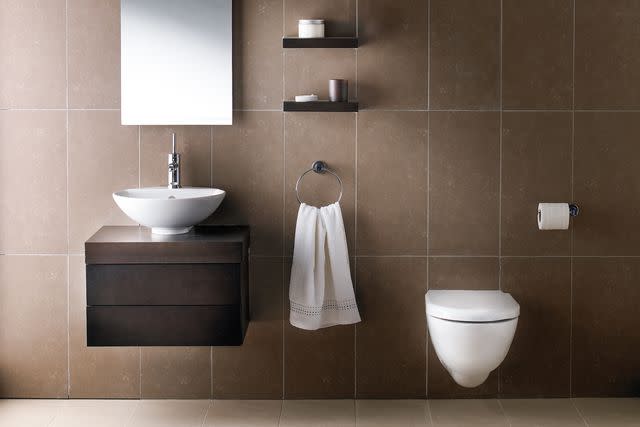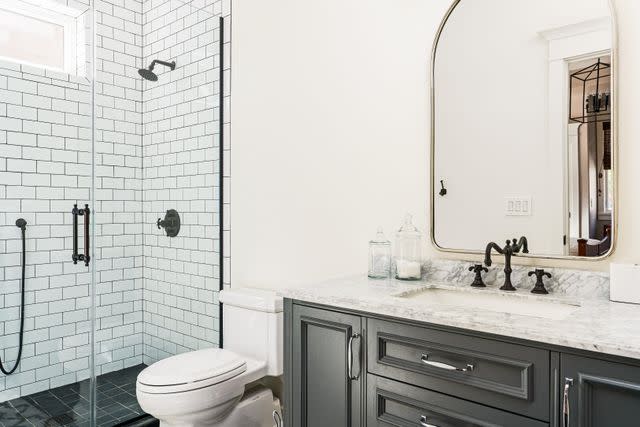How to Unclog a Toilet Without a Plunger (or Chemicals)
No plunger? No problem. Here are seven expert-approved ways to clear the issue right up.
Few things cause as much panic as watching the water in a toilet bowl slowly rise after it's been flushed—but toilet clogs are fairly common plumbing emergencies and almost everyone will face one at some point. Unfortunately, the frequency of these types of unpleasant clogs means you may end up dealing with one at an inopportune time: like when you don't have a plunger or access to a chemical drain cleaner.
Good news: There's more than one way to unclog a toilet—and you can do so without a plunger or chemicals, which you want to avoid anyway (pouring a traditional cleaner or bleach product down the toilet can be deleterious to your pipes and septic system). We checked in with several cleaning experts who shared seven safe methods you can try in a pinch.
Related: How to Clear a Clogged Drain
Safety Precautions
Unclogging a toilet can be messy, and safety precautions are essential when it comes to preventing any potential hazards, says Alicia Sokolowski, cleaning expert, president, and co-CEO of Aspen Clean.
Wear protective gear: Rubber gloves can protect your hands from contact with "potentially harmful bacteria and germs," says Sokolowski.
Remove as much water as possible: For most methods, you'll want to remove as much water from the clogged toilet bowl as possible before you get to work (this will limit your germ exposure); do so by removing the water with a small disposable cup.
Ventilate the bathroom: Working in a well-ventilated space will help with any unpleasant smells or fumes. Turn on your bathroom's vent or crack open a window.
Turn off the water: "Before attempting to unclog the toilet, turn off the water supply by locating the shut-off valve, usually near the base of the toilet," Sokolowski says. "This prevents any accidental overflow during the unclogging process."
Grab a bucket and towels: "Keep a bucket and old towels nearby to catch any overflow or spills during the unclogging process," Sokolowski says.
In addition to these essentials, you'll also need some specific items for each method described below.

drewhadley / GETTY IMAGES
Method 1: Hot Water and Dish Soap
If you have access to hot water and dish soap, you may be able to make a sudsy mix to unclog your toilet, says Marla Mock, a cleaning expert and the president of Molly Maid, a Neighborly company.
Materials Needed
Hot water
Bucket
Dish soap
Steps
Pour a bucket of hot (but not boiling) water into the toilet bowl.
Add a few tablespoons of dish soap to the water, says Mock.
Let the hot water and soap sit so it has time to soften the clog; attempt to flush the toilet.
Repeat the process as needed until the clog is cleared.
Method 2: Forced Flush
Some toilet troubles happen when minor clogs cause your toilet to drain slowly—before you intervene, let gravity do some of the work. "If your toilet has become backed up either due to someone using too much toilet paper or someone having an upset stomach, start by closing the lid and letting the water drain down slowly by itself," says Rochelle Wilkinson of Dirt Detective Cleaning. Wait about 30 minutes to an hour for it to drain completely.
Materials Needed
Hot water
Bucket
Steps
Close the toilet's lid. Wait 30 minutes to an hour for the toilet to drain.
Once the toilet has emptied, fill up your bucket with hot water.
Lift the lid and, with force, pour all of the water from the bucket into the toilet bowl. "This will push the water down from the top as opposed to pushing the handle, causing a swirling action and refilling the bowl," says Wilkinson.

Onzeg / GETTY IMAGES
Related: How to Make a DIY Toilet Bowl Cleaner With Baking Soda and Vinegar
Method 3: Wire Hanger
All you need is an unfolded wire hanger and a little muscle for this method, says Sarah Mitchell from Eco Mama Green Clean.
Materials Needed
Wire hanger (unfolded until straight)
Steps
Unravel the coat hanger until it is straight.
Push the hanger into the toilet and towards the area of the clog.
Continue poking down towards the clog until you see water levels start to dissipate or air bubbles (which mean you've found the source of your problem).
If you choose the wire hanger method, take care when you probe the clog; the wire could scratch porcelain toilet bowls.
Method 4: Baking Soda and Vinegar
According to Wilkinson, you can unclog a toilet using these powerhouse ingredients from your kitchen.
Materials Needed
Hot water
Bucket
Box of baking soda
1 gallon white vinegar
Steps
Fill the toilet bowl with baking soda, focusing on the center of the toilet.
"Take 1 gallon of white vinegar and pour half of the gallon right in the middle of the baking soda pile," Wilkinson says. The mixture should "naturally fizz up" and dissolve the baking soda.
Pour in your bucket of hot water to finish washing away the baking soda/vinegar concoction.
Repeat as needed.
Method 5: Toilet Brush
If you're dealing with a surface-level clog and you're lucky enough to have a toilet brush nearby, you may be able to use it to break up the clog, Mock says. All this entails is putting the bristled end into the toilet and plunging it back and forth in the direction of the clog.
Related: The Ultimate Guide to Cleaning a Toilet
Method 6: Wet/Dry Vacuum
This may seem like an unusual tool to use for a plumbing emergency, but Mock says that wet/dry vacuums can also be used in a pinch.
Set the vacuum to the wet setting.
Place the vacuum nozzle over the toilet drain, creating a seal.
Turn on the vacuum to draw out the clog.
Most wet/dry vacuums have filters that are only supposed to be used on the dry setting. Be sure to double check your vacuum before you use it to unclog a toilet.
Method 7: Plastic Bottle
Make sure you're wearing rubber gloves for this method: According to Mock, you can create a makeshift pressure washer using a large plastic water bottle (you won't need the cap).
Materials Needed
Large plastic bottle
Small plastic cups
Hot water
Steps
Remove as much water from your toilet as possible with a small plastic cup.
Fill the large plastic bottle with hot water.
Cover the opening of the bottle with your thumb and place it nozzle first into the toilet. Press the bottle into the toilet drain, remove your hand, and quickly release and squeeze it. This creates a burst of pressure that may dislodge the clog.
Repeat as necessary.

contrastaddict / GETTY IMAGES
How to Prevent Future Toilet Clogs
The key to preventing future clogs involves being mindful of what you flush down the toilet, says Sokolowski. That means only flushing toilet-friendly materials, like toilet paper and human waste. "Avoid flushing items like paper towels, facial tissues, baby wipes, cotton balls, feminine hygiene products, or non-biodegradable materials," she says, adding that these can easily cause clogs and damage your plumbing.
And if you have little ones at home? Sokolowski says you may want to consider using toilet guards or childproof toilet locks to prevent kids from flushing things they shouldn't.
Troubleshooting Common Toilet Issues
Not every clog is created equal. Sometimes your issue can be caused by a weak flush, which Mock says can be identified and fixed by checking the water level in your tank and adjusting the float or chain. Here are some other common issues to watch for:
Blockages: If you've noticed gurgling sounds, you may be dealing with a problem further down the plumbing line. "This may indicate a blockage in the vent stack; consider using a plumbing snake to clear it," Mock says.
Partial clogs: While not as troublesome as full clogs, partial clogs can also make a mess of things. This is likely the cause if you see the water in the toilet rising, but not quite to the point of overflowing. Unfortunately, the best solution for this problem is a plunger: "In this case, create suction and try to dislodge the clog," Sokolowski says. "Ensure your plunger's cup fully covers the drain opening for better results."
Slow drainage: Water draining slowly is another sign of a partial clog. For this, Sokolowski suggests a plunger or an auger. "If the water level in the toilet bowl rises and then slowly falls after flushing, it might indicate a clog deeper in the plumbing system," she says. In these cases, you may need professional assistance from a plumber with more powerful tools to clear the clog.
Widespread drain issues: Of course, if you've noticed plumbing trouble that extends beyond your toilet, then you may have a back-up in your main sewer line. "In this situation, avoid using plumbing fixtures and contact a plumber immediately to prevent back-ups and potential damage," Sokolowski says.

